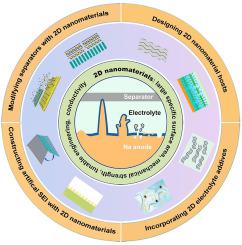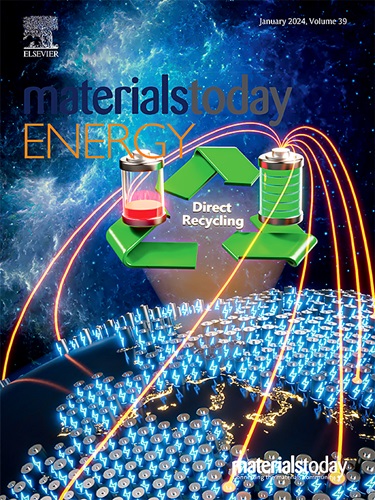通过二维纳米材料工程实现高性能钠金属阳极:综述
IF 8.6
2区 材料科学
Q1 CHEMISTRY, PHYSICAL
引用次数: 0
摘要
钠金属电池(SMB)是一种经济实惠的高能量替代品,可满足未来的储能需求。然而,钠金属阳极(SMA)的商业化正面临着固态电解质相间层(SEI)不稳定、树枝状晶粒生长不受控制以及循环过程中体积变化大等挑战。为了克服这些障碍,人们探索了一系列策略,包括设计复合阳极、人工 SEI、改良分离器以及固态电解质。具有原子厚度的二维(2D)材料具有较大的表面积、诱人的物理化学特性和较高的机械强度,这为实现具有更高的稳定性、循环性能和安全性的 SMB 带来了巨大的希望。在本综述中,我们首先总结了采用二维纳米材料工程的 SMA 的最新发展。此外,还详细讨论了二维纳米材料稳定 SMA 的不同机制。最后,我们强调了二维纳米材料在实现下一代高性能 SMB 方面的未来机遇。本文章由计算机程序翻译,如有差异,请以英文原文为准。

Enabling high-performance sodium metal anodes by 2D nanomaterials engineering: a review
Sodium metal batteries (SMBs) are an affordable and energy-dense alternative to meet future energy storage requirements. However, the commercialization of sodium metal anodes (SMAs) is facing challenges of unstable solid electrolyte interphase (SEI), uncontrolled dendrite growth, and large volume change during cycles. To overcome these obstacles, a range of strategies has been explored including the design of composite anode, artificial SEI, modification of separator, as well as solid-state electrolyte. Two-dimensional (2D) materials with atomic thickness exhibit large surface area, attractive physicochemical properties, and high mechanical strength, which offers great promise for enabling SMBs with enhanced stability, cycling performance, and safety. In this review, we first summarize the recent development of SMAs that employ 2D nanomaterials engineering. In addition, different mechanisms of 2D nanomaterials in stabilizing SMAs are discussed in detail. Last, we highlighted future opportunities for 2D nanomaterials to enable the next-generation high-performance SMBs.
求助全文
通过发布文献求助,成功后即可免费获取论文全文。
去求助
来源期刊

Materials Today Energy
Materials Science-Materials Science (miscellaneous)
CiteScore
15.10
自引率
7.50%
发文量
291
审稿时长
15 days
期刊介绍:
Materials Today Energy is a multi-disciplinary, rapid-publication journal focused on all aspects of materials for energy.
Materials Today Energy provides a forum for the discussion of high quality research that is helping define the inclusive, growing field of energy materials.
Part of the Materials Today family, Materials Today Energy offers authors rigorous peer review, rapid decisions, and high visibility. The editors welcome comprehensive articles, short communications and reviews on both theoretical and experimental work in relation to energy harvesting, conversion, storage and distribution, on topics including but not limited to:
-Solar energy conversion
-Hydrogen generation
-Photocatalysis
-Thermoelectric materials and devices
-Materials for nuclear energy applications
-Materials for Energy Storage
-Environment protection
-Sustainable and green materials
 求助内容:
求助内容: 应助结果提醒方式:
应助结果提醒方式:


